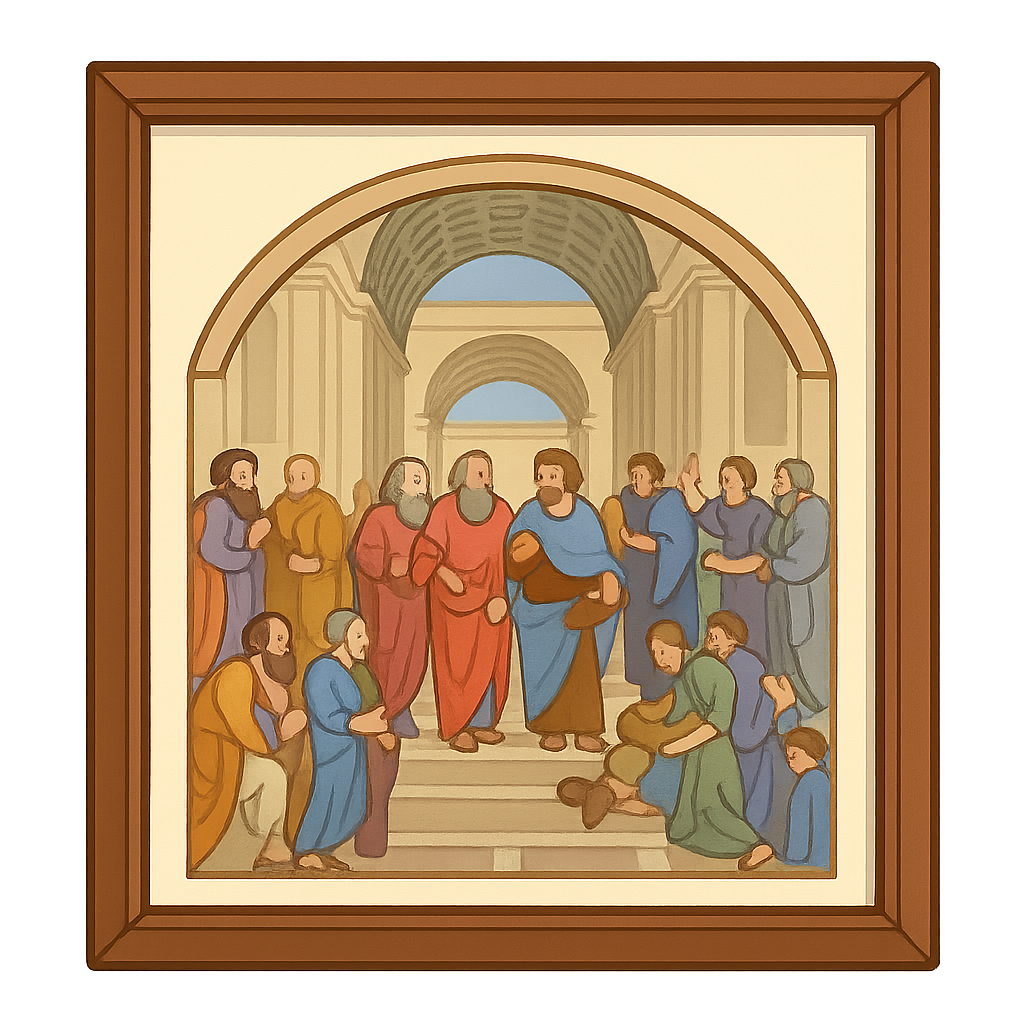The School of Athens
Imagine being a giant picture, so big that you cover an entire wall from the floor almost to the magnificent, curved ceiling. I live in a grand, quiet room where the only sounds are the soft shuffles of feet and the hushed whispers of visitors from around the world. Sunlight streams through the high windows, making my colors glow with a gentle warmth. But the most amazing thing is not the light from outside; it is the life happening right here on my surface. On me, dozens of people are gathered under beautiful archways, frozen in the middle of the most exciting conversation in history. Some are pointing at the sky, others are deep in discussion, and a few are busy drawing complex shapes on the floor. They are all deep in thought, sharing ideas and arguing about the secrets of the universe. It is like the world’s most brilliant party, and I get to host it forever. Can you imagine a room so full of energy, even when everyone is perfectly still? I am more than just paint on plaster. I am a world of ideas, a window into the minds of geniuses. I am The School of Athens.
My story began over 500 years ago with a young man who had a paintbrush in his hand and a universe of ideas in his head. His name was Raphael, and he was one of the greatest artists who ever lived. Between the years 1509 and 1511, he was asked by a very powerful man, Pope Julius II, to decorate the walls of his private library in a place called the Vatican. The Pope wanted his rooms to be filled with beauty and wisdom, and Raphael had the perfect idea. But he did not use a normal canvas. I am a special kind of painting called a fresco. This meant Raphael had to paint me directly onto wet plaster on the wall. As the plaster dried, my colors became a part of the wall itself. It was very tricky work. He had to paint quickly and precisely before the plaster set, but it means I have been a solid part of this room for centuries. Raphael’s big idea was to imagine a dream team of thinkers. What if all the greatest philosophers, mathematicians, and scientists from ancient Greece could meet in one amazing place? In the very center of my world, you will see two important men walking forward. The older man with the white beard is Plato, and he is pointing his finger up to the sky. He believed the most important things were ideas and the world of the imagination. His student, Aristotle, has his hand stretched out toward the ground. He thought it was more important to study the real world we can see and touch. All around them, others are busy learning. Can you see the man in the corner bent over a tablet? That is Pythagoras, figuring out his famous math puzzles. Nearby, another man named Euclid is using a compass to teach geometry to his students. Everyone here loved to ask big questions. And if you look carefully in the crowd on the right, you will spot a young man with dark hair looking right at you. That is Raphael. He painted himself into the party, as if to say, 'I belong with these great minds, too.'
When Raphael created me, it was a special time in history called the Renaissance. It was like the whole world was waking up from a long nap, suddenly excited to learn about art, science, and history again. I was a perfect symbol for this new age. I celebrated human intelligence and showed that all kinds of knowledge, from math to philosophy to art, are connected and beautiful. For more than five hundred years, people have traveled from all over the world to stand in this room and look at me. They gaze at the faces of the thinkers and wonder what they might be talking about. Some visitors are artists who want to study Raphael's amazing skill. Others are students who are learning about the very ideas that Plato and Aristotle debated. I have become the symbol of a place where ideas are born, a poster for the power of the human mind. Even though I am very old, my message is for you, right now. I am a reminder that the greatest discoveries happen when different people share their thoughts. Every amazing invention and every brilliant story started with someone asking a question like, 'What if?' or 'Why?'. Just like the figures on my wall, you have the power to wonder, to learn, and to share what you discover with others. My painted party is still going on, and it is an invitation for you to join in the never-ending conversation of ideas.
Reading Comprehension Questions
Click to see answer
